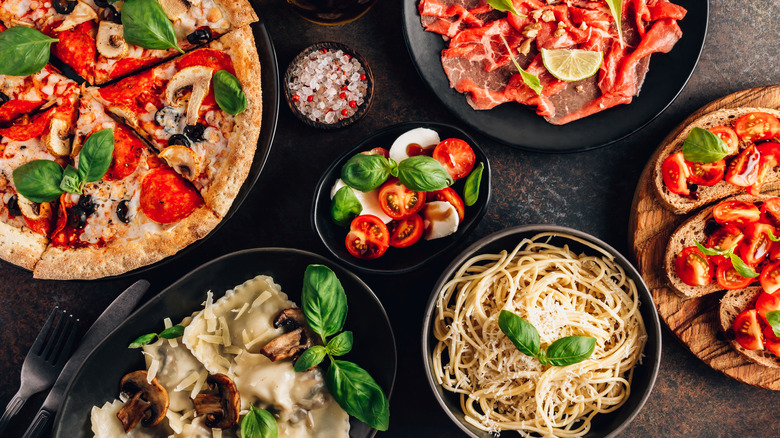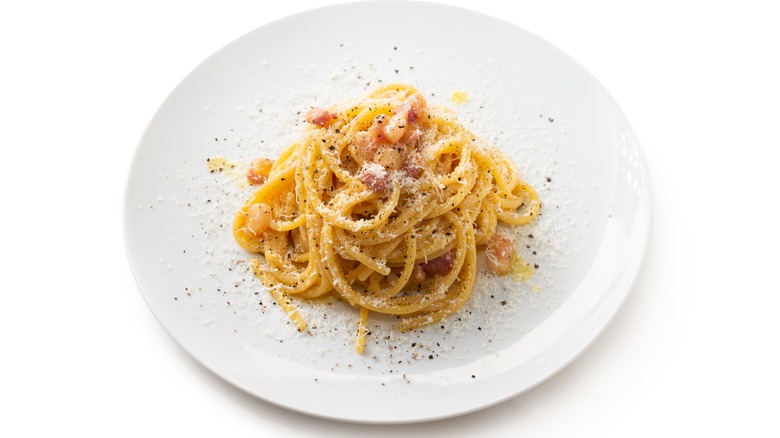The Biggest Myth About Italian 4-Course Dinners
If you've ever been to Italy, or even visited an authentic Italian restaurant, you've likely observed that dinner menus are typically divided into five sections: antipasti (appetizers), primi (first course featuring pastas, rice, and soup dishes), secondi (main courses such as meats and fish dishes), contorni (side dishes accompanying secondi), and dolci (desserts). In Italy, food portions are significantly smaller than American dishes, which might lead you to believe, especially if you're a novice tourist in a small trattoria surrounded by locals, that the protocol is to order a dish from each section. Rest assured, there's no need to order all that food.
There is no Italian dining rule dictating that you must order something from each menu section. Feel free to order precisely what you desire. In fact, that's likely what those locals around you are doing, depending on their hunger levels. Even with the smaller portions, a full four-course Italian meal is a lot of food and is more commonly enjoyed on special occasions or holidays. On any given day of the week, it's perfectly fine if you just want some pasta and a glass of wine.
You don't have to order every course
If you want to eat like an Italian, take a cue from Raffaele Ruggiero, a restaurant manager in Rome. Ruggiero told Food & Wine that, when dining out, most Italians will order an antipasto and then choose either something from the primi menu or the secondi sections, along with a contorno. They'll finish with a dolci. So, a meal out basically includes an appetizer, a pasta or meat dish with a vegetable side, and dessert. However, if you don't want dessert or any specific part of the menu, feel free not to order them.
One thing to note about dining in Italy is that your server will not be in a hurry to clear your table and get it ready for the next party. When you want your check, you'll have to ask for it; it will not automatically be brought to you. As you might expect, Italians enjoy long, leisurely dinners. So, if you do have the appetite for every course, sit back, relax, and order to your heart's content because you'll have the time to enjoy everything at a slower pace.
Like and unlike American dining
A typical Italian dinner out might look similar to an American one. We, too, often start with an appetizer, move on to a main course, and then have dessert. But there are a few notable differences. If you order gnocchi, risotto, or pasta from the primi menu, you'll see that the portion is often about 100 grams, or ½ cup. That would be laughable in the United States, but you can understand why it's common to order multiple courses in Italy.
Your secondi will consist of the piece of meat or fish that you ordered and nothing else; no side of mashed potatoes or green beans. If you want vegetables on the side, you need to order them from the contorni section of the menu. Italian restaurants tend to use only in-season ingredients, as they not only taste better but often come at a more favorable cost to both the restaurant and you. The same concept applies to appetizers and desserts, particularly when they feature fruit.
Some even consider digestifs (after-dinner drinks) and espresso to be courses as well. In this European country, dining is sacred, a joy to be shared deeply with family and friends over laughter and conversation. There is no rush to finish, and all the time in the world to enjoy every bite of food. So if you're looking to immerse yourself in the Italian dining culture, don't feel obliged to speed through your meal. Take your time, savor the flavors, and most importantly, enjoy the experience. After all, that's what dining the Italian way is all about.



